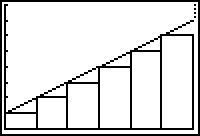| Rectangle | x-coordinate |
Height (y-coordinate) |
Width | Area |
| 1 | 0.25 | 0.0625 | 0.25 | 0.015625 |
| 2 | 0.50 | 0.25 | 0.25 | 0.0625 |
| 3 | 0.75 | 0.5625 | 0.25 | 0.140625 |
| 4 | 1.00 | 1 | 0.25 | 0.25 |
| Total | 0.46875 |

The left-hand Riemann sum is 10.5 square units, the right-hand Riemann sum is 13.5 square units, and the midpoint Riemann sum is 12 square units. The left-hand Riemann rectangles are shown above.
The area bounded by y = 2x + 1 above the x-axis between the vertical lines x = 0 and x = 3 is 12 square units.

We used the window [-1, 4, 1] x [-1, 8, 1] to draw the figure.
A very good estimate of the area under the curve g(x) = 2x + 1 between x = 0 and x = 3 is 12 square units.
The right-hand Riemann sum is 0.3025 square units.
The left-hand Riemann sum is 0.2025 square units.
The Home screen command used to compute the definite integral is fnInt(X^3,X,0,1).

©Copyright 2007 All rights reserved. | Trademarks | Privacy Policy | Link Policy